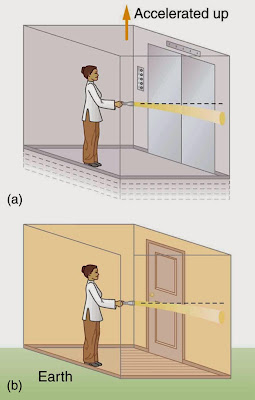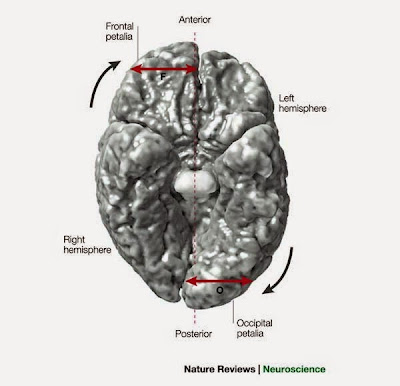Biology concepts – bilateral asymmetry, brain, ventriculomegaly, brain torque, fluctuating asymmetry, sex hormones
Basically, if something is straight, it is correct, unembellished, pure, or not perverted. So what would be the opposite of this? Twisted, of course. Twisted tales are slightly weird or not true to the stories they are taken from. And when you're “a little twisted” you’re thinking is mentally unsound or a bit perverted.
In modern internet slang, twisted means high and drunk, so again it means a perverted form of thinking. Not that it always has to be bad; Stephen King is truly a bit twisted, but he writes well and leads a relatively normal life. Some people bask in the sunlight of their twisted thinking.
But what if I told you that everyone's brains, and therefore everyone's thinking, is just a bit twisted? In technical terms it is called a Yakovlevian torque, but let’s not kid ourselves, it means that our brain is twisted in our skull.
First recognized by the Russian born Harvard anatomist Paul Ivan Yakovlev, the midline fissure where our two cerebral hemispheres butt up against one another doesn’t exactly follow the midline of our skull. There is a slight twist to the left, so that the right cerebral hemisphere crosses the midline to the left behind your forehead and the left hemisphere crosses over to the right side of your skull in the posterior. Everybody’s brain is just a bit out of whack!
see last week’s post), but that isn’t the only source.
Several sources of asymmetry go together to produce brain torque, and it can be greater or lesser in each individual – yes, some people are more twisted than others.
Yakovlev observed that different people had different size depressions on the interior surfaces of their skull in the right anterior and left posterior (called petalias). You can imagine that with a tofu-consistency brain sitting in an opened skull, it might be hard to quickly recognize a slight twist to the left, but Yakovlev wrote about it and hypothesized on its importance.
It wasn’t until 2009 that a couple of studies (here and here) confirmed the torque using very advanced imaging techniques and alot of math. The hard part is accounting for brain position internally and skull midline externally, each of which have fluctuating asymmetries within one individual and variances between individuals. But both studies concluded that Yakovlevian torque is real. Now we just need to figure out it’s significance.
depression and bipolar disorder. One even related atypical torque to developmental stuttering in boys.
On the other hand, a study in autism showed that there was no correlation between autism spectrum disorders and atypical Yakovlevian torque. Well, sort of. This single study only looked at high functioning, right-handed, boys in a narrow age range. So who knows if there might be some relationship between autism and torque in other affected groups. Always be sure to take into consideration the limits of any study you read.
So torque is the norm in human brains; guys and girls both have a leftward twisted to the brain within the skull. There are many more asymmetries in brain than just the ones we have discussed; there are many examples of left > right asymmetries and some of right > left. These differences are evolutionary and are apparent even during the second trimester. But the mechanism and reason for each asymmetry may be different; some are based on gender - boy brains and girl brains are different!
This exception in bilateral symmetry is two fold; there are gender-induced differences in the brain that are both sexual dimorphic – meaning that they depend on the sex hormones or sex chromosome genes of each individual, and they are asymmetric – meaning that the gender-induced structure or function changes affect one hemisphere more than the other.
A 2014 study linked the two phenomena. Apparently regional asymmetries in the male cerebrum and cerebellum are exacerbated compared to female brains through the joint action of testosterone and X-linked genes.
Male brains are more lateralized than females. Functions are segregated more strictly in male hemispheres, so perhaps it’s true that only women use their entire brain.
A few weeks ago we talked about fluctuating asymmetries– those differences in structure size and position from individual to individual. We were talking then about external asymmetries, but peoples’ brains have fluctuating asymmetries as well. One in particular may help predict neurologic disease – and it isn’t even a brain structure.
Several studies go back and forth on whether the size or asymmetry of the lateral ventricles (CSF filled spaces in the brain, see this post) can predict schizophrenia or developmental delays. A 2010 case reportsuggested that alone they may have no particular effect, but if mild ventriculomegaly (bigger than normal ventricles) is accompanied by atypical lateral ventricular asymmetry (the left lateral ventricle is normally a bit bigger than the right), then these may be predictive of delay and/or schizophrenia later in life.
For a more historical example of fluctuating asymmetry in the brain let’s go straight to the top – Albert Einstein. While he was alive people wondered if his brain was different from all of ours. He just thought on a different plane; his concepts were Earth shattering, yet he used thought experiments with elevators in space and passing trains.
In 1999, a qualitative and quantitative study of the data and measurements recovered from Einstein’s brain was carried out, comparing it to 5 male and 56 female brains. The researchers’ results were shocking for what they did and didn’t find.
First, Einstein didn’t have a huge brain, it was basically the same size as everyone else’s. There weren’t extra lobes or a million times more neurons – it looked like a regular brain on first glance. But that’s where science comes in; scientists don’t stop at a first glance.
For one thing, Albert’s brain was missing a certain landmark. Without getting technical, there are two fissures (sulci) that usually pass by one another and create a little island of tissue near the temporal/parietal lobe border. Well, Einstein’s didn’t pass by one another, they merged. This allowed more room for brain tissue since there was only one fissure instead of two.
 |
Long before he could measure the bending of light by massive objects, Einstein thought about how shining a light on Earth (force of gravity), and shining a light in space elevator (force of acceleration) might show how light illustrates general relativity. It took long expeditions and many years, but his idea was finally proved correct by measurement of sunlight during an eclipse. |
Why might this fluctuating asymmetry be important? Did it have a functional correlate? That would be hard to tell since the brain isn’t firing now. Wouldn’t it have been great if functional MRI had been around when Albert’s brain was still in Albert’s living head? I bet he could have lit up most of Princeton – but I digress.
The parietal lobe has many lateralized functions, but some of them are right in Einstein’s wheelhouse. This lobe is important mathematical reasoning, and for connecting visual, somesthetic and auditory stimuli together into a big picture.
Take all this together and what you get is that the parietal lobe is what creates mathematical relationships, conscious or unconscious, amongst the world and its moving parts. Professor Einstein was better at that than everyone else, so maybe his wider than normal parietal lobe was responsible.
Of course this doesn’t let the rest of us off the hook. Plenty of people do some awesome thinking and reasoning with very ordinary brains. As we have shown before in this blog – exercise your brain and it will become sharp. Use it or lose it.
Next week, more internal asymmetries in those bilaterally symmetric animal bodies. Your lungs are for breathing, but right and left don’t participate equally – and there’s some cool math involved, so warm up your parietal lobes.
For more information or classroom activities, see:
Gender differences in brains –
Yakovlevian torque –
Albert Einstein’s brain –


















